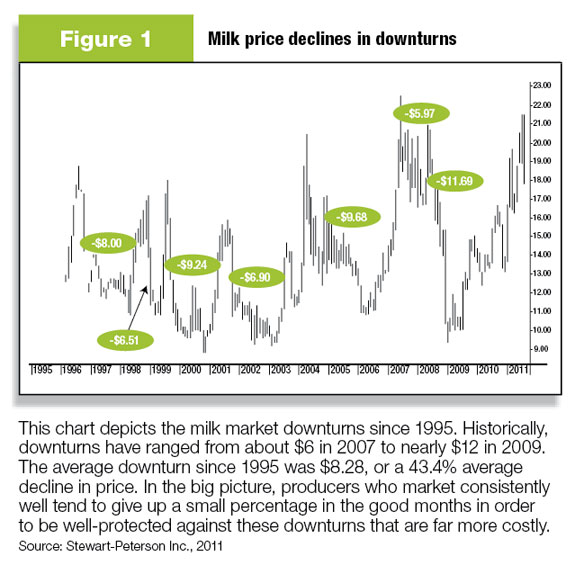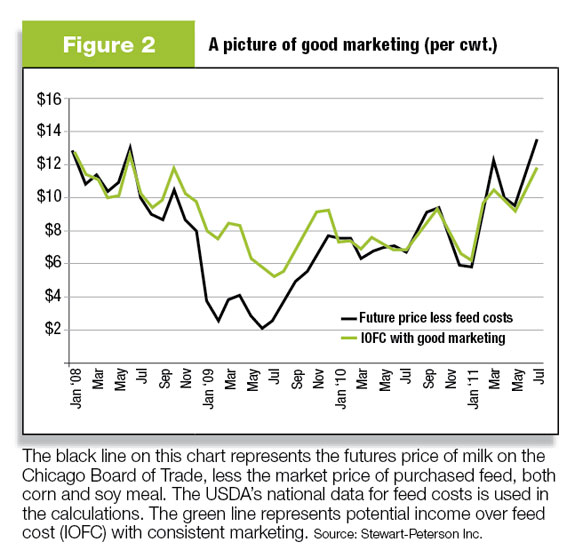Of all the tasks on a dairy producer’s to-do list, where does marketing fit? For some, it ranks up there with calculating rations or managing employees. For others, it is an inconsistent effort that gets attention on occasion. For still others, it is a very low priority. In the 15 years since the dairy markets have been in place, most dairy producers have fallen into the latter two categories. So if you are looking for evidence that marketing is worth the effort, you’ll find there is very little data documenting the cumulative effects of consistent marketing.
There simply haven’t been many dairy producers who have consistently implemented a goal-oriented marketing approach and tracked the performance over time.
Volatility in world markets – currencies, energy, agricultural products – is impacting producers and making some form of risk management essential. When it comes to choosing an approach, producers want to know, “How does this approach perform?”
Producers want to see results. And marketing is an animal with a steep learning curve and a long ROI tail, making its long-term impact hard to calculate.

Short-term vs. long-term results
How quickly one sees results in marketing depends in part on where in the cycle he or she begins. Those who start marketing at the top of a price cycle believe in it because they are engaged as prices begin to fall.
Those who enter at the bottom of a cycle, while consistently capturing prices on the way up, are also trailing behind the market (though ideally it is only slightly behind in the big picture).
If a producer consistently applies a disciplined marketing approach for both feed and milk throughout an entire milk price cycle, he or she could truly evaluate whether marketing makes a difference.
For easy math, let’s assume you have a 1,000-cow operation with an average production of 20,000 lbs per cow. We can then assume that when prices are high – say, $20 per hundredweight (cwt) – you are grossing $400,000 a month. And when prices are low – say, $10 per cwt – you are grossing $200,000 per month.
Then, let’s assume that with good marketing, you capture even just a third of the downward price swing from the high of $20 to the low of $10. That would be roughly $3.30 per cwt of a $10 move.
In this scenario, when you look at the times when prices are low, you would be gaining $66,000 per month, which translates to increasing your revenue by 33 percent of your $200,000 gross.
Now let’s look at what would happen in an up market, when prices are high. Let’s look at a conservative scenario and say that you trail the market by $3.30 per cwt in your efforts to incrementally capture opportunity and use marketing tools to protect yourself from a price decline.
That $3.30 per cwt you “gave up” would translate into cutting your gross income by $66,000 on your $400,000 gross, or 16 percent per month.
When we compare the two scenarios, we see the following:
• In a down market, you’re increasing your gross revenues by 33 percent.
• In the up market you’re decreasing your gross revenues by 16 percent.
Now let’s look at it from yet another perspective. First, we have found that in up markets, with both our Model Farm recommendations and our experience with customers, the $3.30 per cwt “behind the market” used in the example above is extreme.
In reality, the cost of marketing in an up market should be lower than that. Your marketing goal in an up market is to track as close to the market price as possible, while still implementing your risk management strategies.
More importantly, think of the impact of this consistent marketing on your overall bottom line and net profits long term. When prices are down and your gross revenues are down, those extra dollars dramatically impact the percent change in profits.
That is real money when you need it most. When prices are high, yes, you may be giving up some real money also, but as a percent of gross and net, it is not as impactful.
When we survey producers who do not engage in consistent marketing, they commonly tell us they do not put the time or effort into marketing because they expect they will give up as much as they will gain. They assume it will be a zero-sum effort.

In reality, consistent, disciplined marketing can dramatically impact your bottom line when prices are low, and it should only make your good profits and financials look “a little less good” in the good times.
You should still be making very good money when prices are high. ( See Figure 2 .)
I completely understand how counterintuitive it is to continue consistent marketing when every other aspect of your dairy has immediate needs that often offer more short-term, visible results.
However, many of the dairy producers I know are in the dairy business for life, wishing to pass the business on to the next generation. That’s one of the unique and wonderful things about our dairy industry.
Today’s economic environment compels us to look at things differently than we have in the past. Volatile markets require an unwavering, disciplined approach and longer-term thinking than perhaps we would use with most other management areas on our farm.
When you’ve tracked the results of a consistent approach through an entire price cycle, you can truly evaluate whether marketing made a difference for you. PD
Futures trading involves the risk of loss and should be carefully considered before investing. Past performance may not be indicative of future results.

Who deviates from an adviser’s recommendations and why?
Those clients who do not follow our recommendations typically deviate during the bullish ride up in prices. Because they are bullish, they tend to limit any forward pricing.
They reinvest in their facilities, and some even expand and add cows. As the market cycle approaches its top, they are at maximum risk, having replaced their incremental pricing discipline with bullish outlook.
In contrast, clients who consistently follow our recommendations continue to make moves such as:
• Incrementally capturing market opportunity
• Making strategic sales to shift risk
• Following the market with stops
• Purchasing puts to protect while maintaining opportunity
• Using fences to bring down the cost of protection
Emotions are the biggest culprit standing in the way of consistent marketing decisions. The short-term impact of being behind in a bull market leads many producers to abandon their marketing goals and leaves them unprepared and unprotected when the market turns.
—Matt Mattke ( above right) , Market 360® Dairy Adviser, Stewart-Peterson Inc.

Mark Ludtke
Market Adviser
Stewart-Peterson
mludtke@stewart-peterson.com





